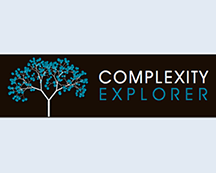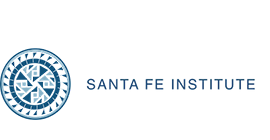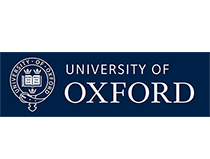Algorithmic Information Dynamics: From Networks to Cells
The surprising origins of life's complexity
Turing dies in 1954, one year after the discovery of the double-helical structure of DNA by James Watson and Francis Crick, but before biology's subsequent revolution. Neither he nor von Neumann had any direct effect on molecular biology, but their work allows us to discipline our thougths about machines, both natural and artificial
This course will draw heavily upon information theory and complexity science to explore the cutting-edge field of systems and network biology. This will be a computer-program oriented course on tools of information and computer science for computational biology.
Summary
This course will provide a novel but comprehensive overview of formal analytical tools for network biology. Biological systems, such as organisms and all their constituents, are today extensively studied as interactions between units forming complex networks. Reconstructing these networks from noisy and incomplete data and finding measures that derive biological meaning from them are among the most important challenges in the field, and among the most exciting directions in synthetic biology.
If you are familiar with statistical mechanics as the means used by modern physics for producing new theories of complex phenomena, then consider that statistical mechanics is to physics what systems biology is to biology. Like statistical mechanics, systems biology is a different approach to understanding and extracting knowledge from nature (high-dimensional, incomplete data), for which local predictability is difficult, if not impossible. Unlike in physics, where energy constraints or fundamental measurement limits sometimes get in the way, in systems biology one can descend to the smallest biological scales and verify interactions, such as genes regulating other genes.
To these ends, tools from information theory, complexity science and dynamical systems can be applied and exploited, leading to new biological insights and exciting discoveries in the domains of artificial life and synthetic biology.
Preliminary Syllabus
- Biostatistics and the power of data (hypothesis testing, data analysis)
- Basics of molecular biology and sequence analysis (the main principles, transcription and translation, the cellular machinery)
- Combinatorial complexity of life and diversity in nature (information entropy, open-ended evolution)
- The essence of life (computation, universality, artificial life, synthetic biology)
- Behaviour and dynamics of natural and abstract systems (cellular automata, morphogenesis, non-linearity)
- The power of randomness and the complexity of life (pseudorandomness and unpredictability in deterministic systems)
- Computation in life and carriers of information in biology (organization, emergence, algorithmic information)
- Nature inspired algorithms (neural and evolutionary computation, unconventional computing, Monte Carlo method, simulation)
- Small data matters (graph theory, complex networks, network motifs)
- The two faces of the network biology coin (studying networks and reconstructing networks)
- Structure in nature and network biology (algorithmic probability, logical depth)
Recommended Literature
- U. Alon, Introduction to Systems Biology: Design Principles of Biological Circuits, Chapman and Hall/CRC, 2006.
- S. Brenner, Life's code script, vol. 482, pp 461, Nature 2012. [PDF]
- T.M. Cover, J.A. Thomas, Elements of Information Theory, Wiley-Blackwell, 2nd Edition, 2006.
- D. Gusfield, Algorithms on Strings, Trees, and Sequences : Computer Science and Computational Biology, Cambridge University Press, 1997.
- M Li and P. Vitànyi, Introduction to Kolmogorov Complexity and Its Applications, Springer Verlag, 3rd ed. 2008.
- A. Ilachinsky, A Discrete Universe, World Scientific Publishing Company, 2001.
- Walhout & Vidal & Dekker , Handbook of Systems Biology, Academic Press, 2012.
- S. Wolfram, A New Kind of Science, Wolfram Media, 2002.
- H. Zenil (ed.), Randomness Through Computation, World Scientific Publishing Company, 2011.
- H. Zenil (ed.), A Computable Universe, World Scientific Publishing Company, 2013.
Meet the instructors
Hector Zenil and Narsis Kiani are assistant professors at the Unit of Computational Medicine at the Karolinska Institute in Stockholm and co-lead the Algorithmic Dynamics Lab.
Hector Zenil has a PhD in Computer Science and was a postdoctoral researcher at the Behavioural and Evolutionary Theory Lab, Department of Computer Science of the University of Sheffield in the UK. He is also the head of the Algorithmic Nature Group, an invited member of the Foundational Questions Institute (FQXi) and a senior consultant for Wolfram Research. He is the editor of A Computable Universe and Irreducibility and Computational Equivalence published by World Scientific/Imperial College Press and Springer Verlag.
Narsis Kiani has a PhD in Mathematics and has been a postdoctoral researcher at Dresden University of Technology and at the University of Heidelberg in Germany. She is currently a VINNOVA Marie Curie Fellow in Sweden.
Antonio Rueda-Toicen (Teaching Assistant) has an MSc degree in Bioengineering and a Licentiate degree in Computer Science. He is an instructor and researcher at Instituto Nacional de Bioingeniería (INABIO) at Universidad Central de Venezuela.
General Information
- Language: English
- Course starts: TBA in 2017
- Course length: TBA
- Estimated effort: TBA
Instructors
Dr. Hector Zenil and Dr. Narsis Kiani
Unit of Computational Medicine, Karolinska Institute
Supporting Material
To run download the Wolfram CDF Player for free
- Shannon's Noisy-Channel Coding Theorem
- Random Number Generation
- Prediction and Entropy of Languages
- Cellular Automata Compressibility
- John von Neumann's First Pseudorandom Number Generator
- Country Data and Benford's Law
- Random Number Generation
- Generating Random DNA Sequences
- Busy Beaver Turing Machines
- Kolmogorov Complexity of 3x3 and 4x4 Squares
- Infinite Monkey Theorem and Algorithmic Probability
- Zipf's Law for Word and Letter Frequencies
- Network Motifs and Graphlets
- Breadth First Search Enumeration
- Complex Networks







